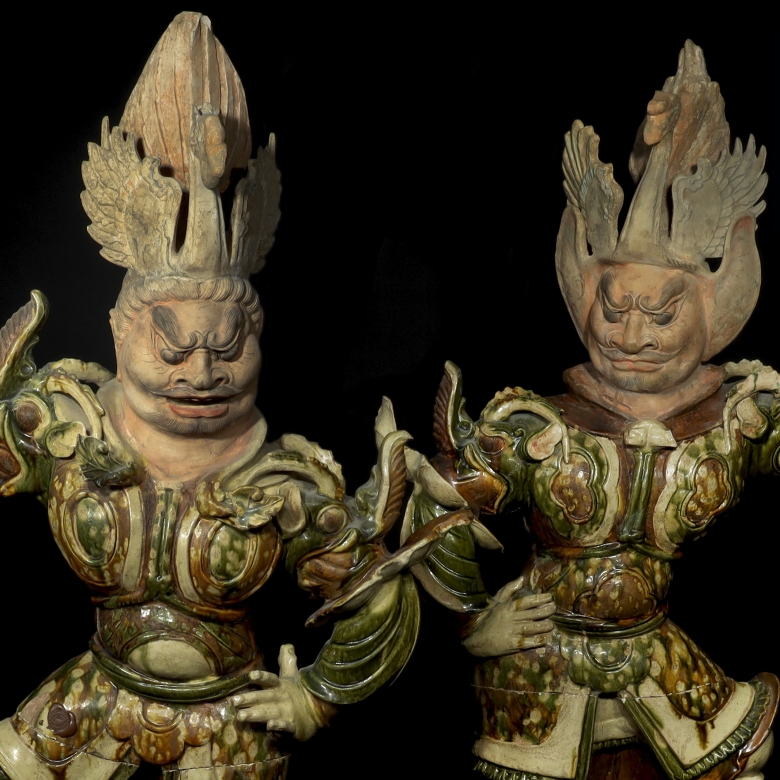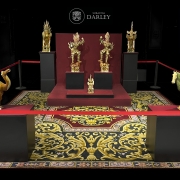ASIAN ART AUCTION 29 DECEMBER 2022
Pair of 'Lokapala' guardians in Sancai-glazed ware, Tang dynasty (618 - 906)
Press 'Program an autobid'in order to confirm
A pair of figures delicately modelled in kaolin ware and covered with a glossy glaze in a 'sancai' (amber, green and cream) shade and polychrome for the face. There are hollows on the inside.
The figures are standing with threatening bodily expressions, each with an opposite arm raised as if to hold a spear. The weapons are not preserved because they were probably made of wood. The other hand is resting on their hip as they raise the opposite knee. These footsteps on the head of a recumbent animal that acts as a support on an irregular pedestal. The details are delicately executed and show a complete articulated armour, where the epaulettes on each shoulder in the form of masks of mythical beasts with horns stand out. During their execution, they have been made in two parts that join at the waist.
The faces are unglazed, but are covered with an engobe, worn by the passage of time, which emphasizes their features. They are masterfully modelled, showing piercing eyes, a broad nose and a mouth with thick lips that together form a fierce expression. One of them has a closed mouth and the other an open mouth, as was customary for pairs of guardians. The headdress is tall with a winged helmet covered with a decorative engobe. Finally, below the helmet they have a different headdress, one of them with his hair tied up in a high bun and the other with his hair covered by a leather cap.
The height of these figures and their state of preservation are exceptional, considering their age. They have undergone some restoration work, although they have retained their integrity.
Height: 112 cm
Documentation:
Accompanied by a report and "Thermoluminescence Test" carried out by the TL Laboratory of the Autonomous University of Madrid (UAM). Report no.: 10021R, year 2005. The result confirms, from the extraction of material from the piece, compatibility with ceramic materials fired in the Tang dynasty period and age close to the 7th - 9th centuries AD.
Provenance:
Spanish private collection.
This important private collection comes from a successful businessman dedicated to national and international construction and investment who lived in different parts of Spain and the South of France. This part of the collection, exhibited exclusively for the first time at auction, focuses on Chinese ceramics from the Tang Dynasty and is a collection of museum quality pieces. The family's tradition of travel dates back to the success of an ancestor who in the 1930s travelled to Manila, Shanghai, Cairo, Havana, etc., practising the sport of "cesta punta", and in particular, motivated by an interest in discovering different cultures, which led them to build up a large collection. In general, their interest in art is such that their collection includes pieces of both Asian and European origin.
The acquisition of the collection began in the 1990s and was built up during years of study in Madrid and on various trips to Paris, New York, Hong Kong, Spain and Germany; at reputable antique dealers such as "Arch Angel" in Hong Kong and international auctions such as Nagel. To this end, specialists have also collaborated in the selection, study and verification of the pieces, as can be seen in the accompanying documentation: invoices, studies and reports.
Additional information:
The function of these figures was to protect the tombs and accompany the deceased, and they were endowed with visual qualities for this purpose. The first such figures were seen in the tombs of Li Feng, Prince of Guo (622-675). Large 'sancai' figures of better quality were included in the tombs of royalty and nobility, both in the Chang'an capital of the time and in the city of Luoyang. During the Tang dynasty, Henan province was one of the richest places in the empire.
They are decorated with brightly coloured glazes that can be seen on many pieces from the Tang period, from the 7th century onwards. The type of glaze was called "Sancai" (三彩) because of the use of three low-temperature firing colours. They are coloured by metallic oxides of copper, iron and manganese. They are an evolution of the tradition of Han and Wei single-coloured wares. The material used to make these ceramics is kaolin with fine white texture and glossy glazes, representing the peak of the development of coloured glazed ceramics in China. The result is a magnificent and dazzling artistic effect. An example would be the set of figures in the Luoyang Museum "洛陽博物館" and the Shaanxi History Museum "陕西历史博物馆".
The main guardians were the so-called "lokapalas" and here too they are associated with the protection of Buddhist shrines against evil spirits. They stand in pairs, assume similar postures and wear warrior attire in keeping with their protective role.














































